Celebrities are will for De Gournay’s hand-painted wallpapers are
Its exquisite hand-painted wallpapers may draw on a dream of the past but de Gournay’s ideal of beauty is proving to have timeless appeal.
If walls could talk, then those swathed in de Gournay’s magnificent bespoke hand-painted wallpapers must surely reveal the best stories. From flying fish and leaping warriors to butterflies flitting through vines of roses or peonies; from coral pink flamingos grazing languidly across watery landscapes to panoramic scenes, washed in sepia tones, depicting early India, based on the aquatints of 18th-century English landscape painter Thomas Daniell and his nephew William.
These are just a few of the painterly narratives de Gournay has brought to life since former chartered accountant and financier Claud Cecil Gurney and his nephew Dominic Evans-Freke founded the brand specialising in hand-painted wallpaper, fabric and ceramics in 1986.
Late last month, the publication of de Gournay: Hand-Painted Interiors (Rizzoli), written by Gurney, celebrated more than three decades of the company’s place at the forefront of its bespoke field. It is lavishly illustrated with photography from many of its projects, including private homes spanning the globe, from New York to Beijing, and London members clubs such as Robin Birley’s 5 Hertford Street, designed in collaboration with former fashion designer Rifat Ozbek, and Martin Brudnizki’s recent reinvention of Annabel’s. There are hotels, such as the Haymarket Hotel, where Kit Kemp has wrapped L’Eden, a crystal grey panoramic, around all four high-ceilinged walls of the Shooting Gallery, and more than a hundred gilded panels depicting the Voyages of Captain Cook on the walls of The Ned.
Indeed, “de Gournay” has become shorthand for a certain kind of luxurious, aspirational, beautifully crafted interior that is instantly recognised by those in the know. “People occasionally stop to tell me how wonderful de Gournay is, and what lovely taste we have, and how we have made the world a better place,” says Gurney, flattered but also bemused. “I often ask myself whether there is any such thing as ‘de Gournay taste’,” he says. On reflection, he believes the company’s success lies truly in the hands of its talented decorators and designers.

While de Gournay’s first clients were those wanting an “instant aristocratic eternal feel, as if their family had been around for a thousand generations”, says Gurney, today it is leading interior designers, such as Miles Redd, former creative director of Oscar de la Renta Home; Michael S. Smith, who refurbished the White House during Barack Obama’s presidency; Californian modernist Kelly Wearstler and French colour genius India Mahdavi who really push the company’s design boundaries.
This owes much to former fashion turned interior designer Matthew Williamson, who was the first person “to take our wallpaper and make it his own”, enthuses Hannah, one of Gurney’s daughters who is now involved in the business, overseeing marketing and communications (his other daughter, Rachel, handles sales). When Williamson opened his Bruton Street store in London in 2004, he used Earlham, one of de Gournay’s most iconic chinoiserie papers, customising the feathery plumes of birds in the pattern with fluorescent bright orange, bright pink and bright green paint, and pinning antique brooches through their beaks. Until that point, “we had been making our papers look antique, as if they’d been on the walls for hundreds of years,” says Hannah, citing original designs inspired by those found in some of Britain’s grandest houses, such as Chatsworth and Nostell Priory. “But after Matthew did something super-fun, vibrant and young with it, we started adding in our own neon accents.” Today, “we’re very lucky to work with designers who are absolutely amazing”, adds her father. “They really play with the scale and background, moving elements around, creating something contemporary from a design that is very classical. We’re happy to do whatever they want to do.”
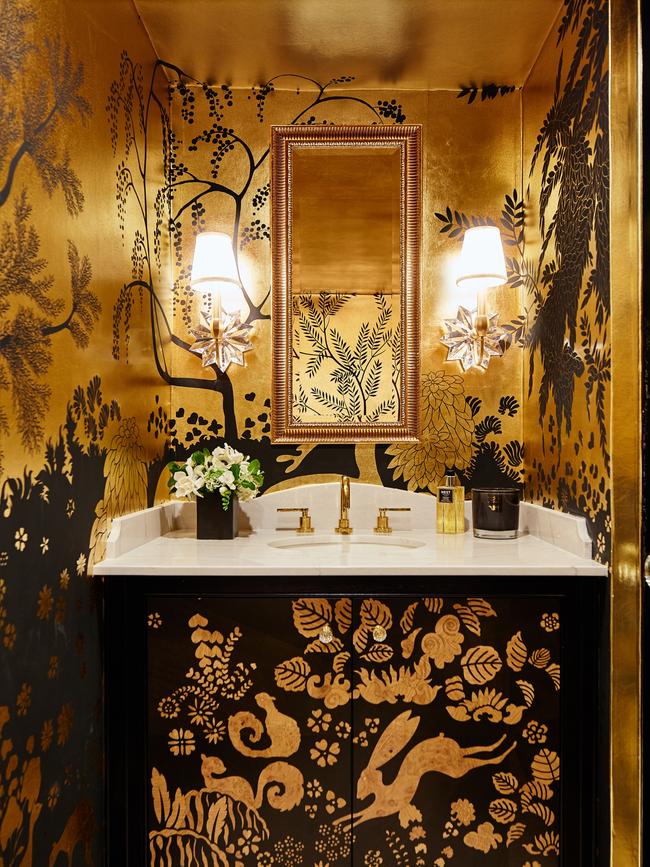
The idea for de Gournay – named after the original 16th-Century Norman version of the family’s surname – came to Gurney in the early eighties after he searched fruitlessly for affordable chinoiserie to use in his London home. “At the time, the only papers available were very expensive antique panels removed from great houses,” he says. So instead, as the Chinese economy began to open up to the western world, Gurney decided to create his own. When he went in search of artisans specialising in chinoiserie painting, he quickly discovered that many of those traditional 18th-century skills were no longer being kept alive.
With help of master painter Lu Jin Ling and the Chinese National Society of Arts & Crafts, whom he met through the Trade Department at the Chinese embassy in London, he sourced the right artists, silks, papers and brushes to bring the art of Chinese painting to de Gournay. After the first two years, and considerable investment, Gurney admits he had filled his outbuildings on the family farm in Kent with sub-standard wallpaper. “The background colours did not match, the silk was defective, and the painting did not match from panel to panel,” he laments.
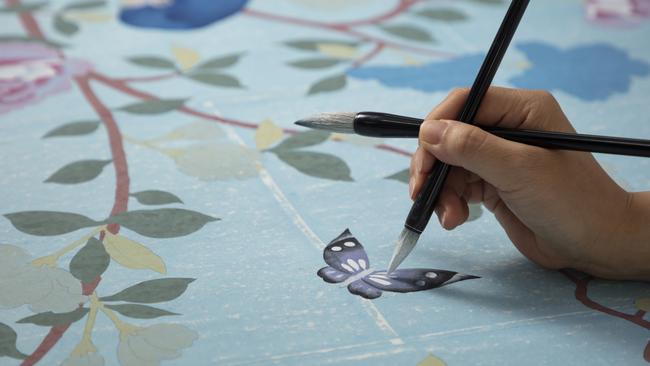
He went in search of a Mandarin-speaking manager to help gather a team of artists to work exclusively for de Gournay. “The primary purpose of our operation was quality, quality and quality, as it has always been since,” he says. Joining forces with his nephew Dominic proved pivotal. “Dominic’s relentless attention to detail, great artistic talent and ability to get along with our Chinese staff allowed us to flourish,” he says.
“My father achieved the perfect equilibrium, reigniting traditional chinoiserie skills with a contemporary insight into the influences of 18th-century France and Britain,” says Hannah.
The beauty of de Gournay’s hand-painted wallpapers, fabrics and porcelain is a world away from digital printing and mass production. “Our clients fight to find something more unique,” says Hannah, pointing out that a team of 120 artists might take up to 10 days to complete just one panel (longer if it is one of the brand’s papier peints panoramique, painted in the same original 19th-century block-printed style).
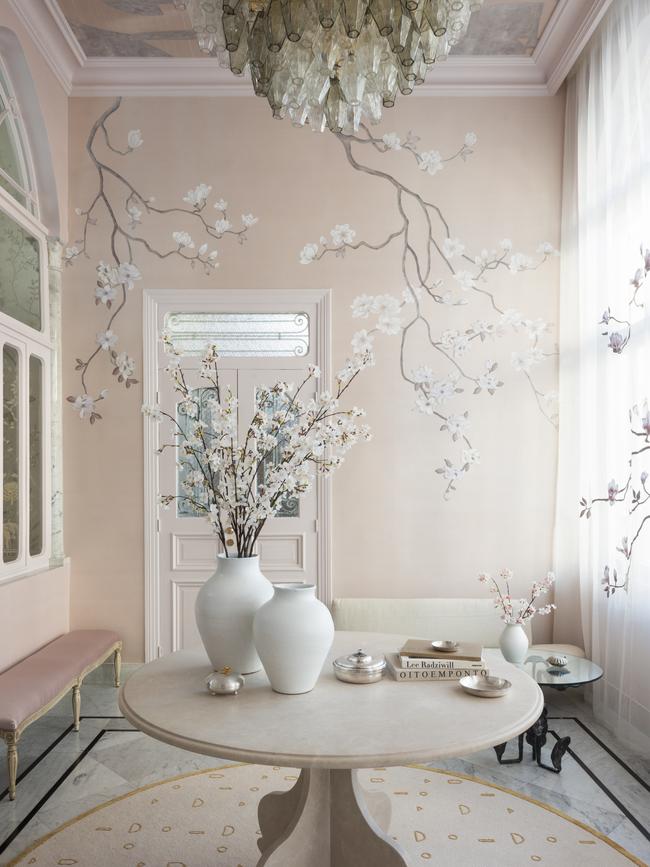
Thinking outside the box is a de Gournay trait, providing continual motivation for innovation and experimentation. From the development of the Relievo 3D technique, which mimics the sculptural effect of a wall being carved out of stone or cast in bronze, the use of Japanese grass papers or working with muslin rather than voile, to the three-dimensional embroidery done in India that make flowers seem as if they’re coming out of the wallpaper, sometimes “it’s often down to the materials you don’t even notice have been incorporated into the wallpaper design that are being innovated”, says Hannah.
de Gournay’s ability to intricately personalise and hence make each project distinctly unique is what makes its designs so inspirational. “My father talks a lot about wabi-sabi – the beauty of imperfection. To be in a room where everything is done by hand brings a whole lot of soul to a space.” It is certainly why The Metropolitan Museum worked with the company five years ago for its exhibition “China: Through the Looking Glass”, for which de Gournay provided its “Abbotsford” hand-painted silk as extravagant stage curtains and “Earlham” hand-painted wallpaper on emerald green dyed silk for the dining room (even hand-painting the fabrics for tablecloths) for that year’s lavish Met Gala ball.
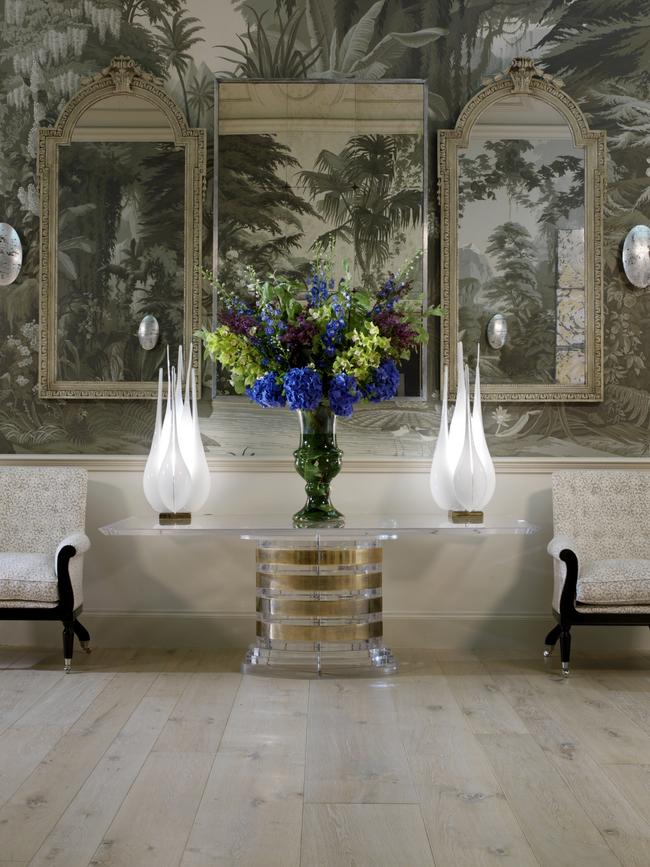
A dress in Alexander McQueen’s Autumn Winter 2006/2007 collection took direct inspiration from “Portobello”, a pattern based on an 18th-century chinoiserie of roses and bamboo, birds and butterflies. Kate Moss worked with de Gournay’s head of design, Jemma Cave, to create a series of patterns, including “Anenomes in Light”, for her homes in London and the Cotswolds. More recently, Hannah has initiated collaborations with Aquazzura on a pattern called “Amazonia”, a tropical chinoiserie featuring toucans, parrots and palm leaves, which then translated into fabric for heels and loafers. The British designer Erdem Moralioglu created fruits and flowers for a wallpaper motif that was then adapted into a fabric used for a capsule collection of clothing earlier this year. For Houghton Hall, the 1720s stately home built in Norfolk for Britain’s first prime minister, Sir Robert Walpole, Hannah worked with Rose Hanbury, Marchioness of Cholmondeley, to reproduce in three colourways an 18th-century chinoiserie panel found immaculately preserved after being stored in the attic for more than 250 years.
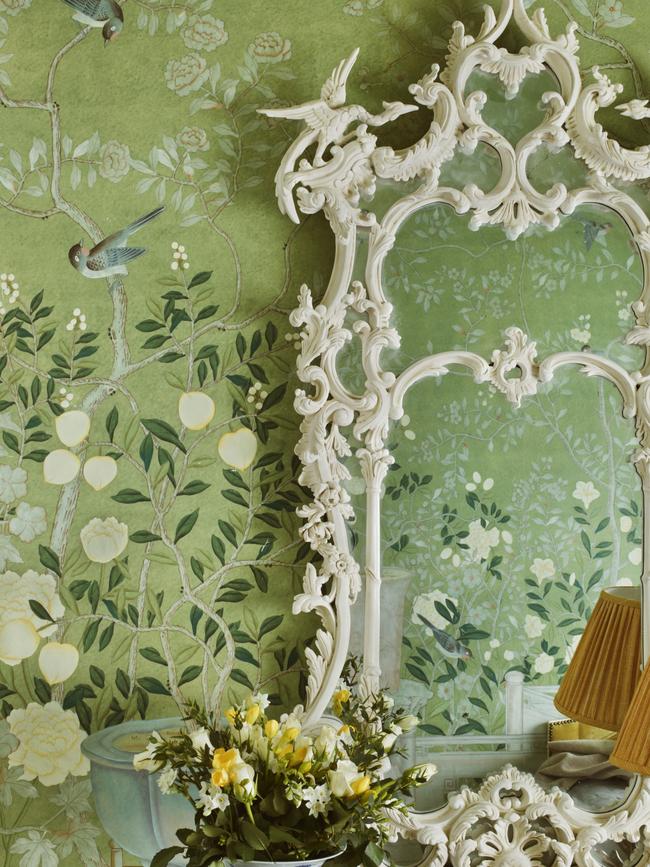
Other fans include Cameron Diaz, John Galliano and the Prince of Wales; and the brand’s designs feature in films and advertisements, from “Temple Newsam” in Baz Lurhmann’s The Great Gatsby and “Portobello” in an ad for Chanel’s Coco Mademoiselle with Keira Knightley.
The company, which now has showrooms in London, New York, Paris, Moscow, Shanghai, San Francisco, and most recently, Beirut, thrives on the irrepressible energy of its founder. “He is already on to the next idea before his previous idea has even become a thing,” says Hannah. “And because he is always full of ideas and passion, and even though de Gournay has been going for more than 35 years, it always feels like this is just the beginning. There is never a sense of complacency – we are always open to doing new things, going in new directions.”
Gurney says he owes his energy to his mother. “She would bring me tea in bed and tell me each morning to ‘shake my hoofs’, to not waste a second of daylight,” he writes in his new tome. While his mother gave him insight into the arts – the opera, ballet and painting – she also schooled him in the practicalities of life, from milking a cow and riding horses to looking for bargains at local auction houses. After an early career working for what was then Coopers & Lybrand, travelling widely from Tunisia, Senegal and Saudi Arabia to Switzerland, Boston and the Cameroons, he studied for a master’s in economics at the University of Chicago.
Hannah says it is no surprise if her father suddenly buys a house in Calcutta or suggests opening a new showroom in a city where she has never been. “There’s no doubt we could have opened a showroom in Miami and Atlanta instead of Shanghai and Beirut, and we probably would have made more money. But I don’t think money’s really what drives us,” says Gurney. “Instead, like me, Hannah loves the world and loves all the people in it. I remember running around the world with my mother as a child, being in Egypt or Lebanon. Travel has always been exciting and it’s what we love to do.”
The result is that in de Gournay’s world, anything goes. “Give me risqué any day,” enthuses Gurney.
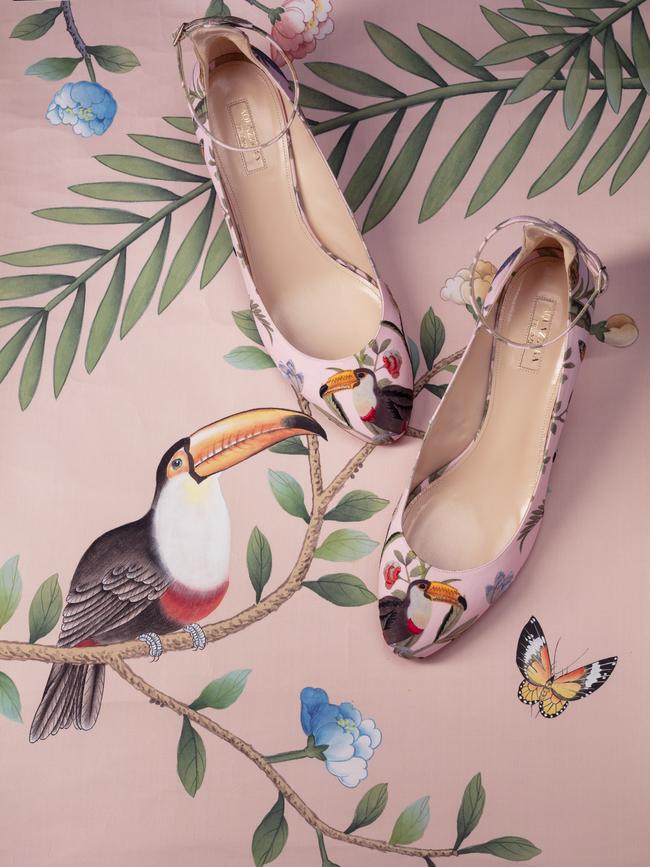
Hannah agrees – every inch of her own home is a kaleidoscope of colour and pattern, where more is always more. The “Coco Coromandel” pattern, hand painted on Xuan rice paper, in the living room was inspired by Coco Chanel’s apartment in Paris; in the master bedroom hangs one of the first chinoiseries Gurney created 35 years ago. In the mix are antique chairs and geometric rugs, candy-hued terrazzo bathroom floors, and Carlo Scarpa-style smoky Murano glass wall lights. It is living proof that a wall is just a wall “until you put some de Gournay on it”, Hannah enthuses. “The fact that somebody has hand-painted something for you, and that you’ve been involved in its design, immediately brings much more meaning to a home.”
Hannah also relishes the brand’s growing popularity among the younger generation. “Back at the beginning of the business, the focus was on wallpapers that belonged in beautiful old family houses that had history and gravitas,” she reflects, “but now it is fun to see all of my friends in their twenties and thirties wanting a little piece of de Gournay somehow, whether it’s a wallpaper or a shoe.”
Doing things differently is what continues to make the brand so interesting. Some collections are historical, like the Emperor’s collection in 2015 based on the very traditional Chinese murals that were only seen by, and painted in, the East, while others reflect new thinking, like the collection shown in January by young Korean designer Teo Yang, which explored concepts of still-life painting from Korea’s Joseon period.
Two years ago, the American designer Alessandra Branca transformed the brand’s Paris apartment, located above de Gournay’s store in St Germain, into a majestic evocation of 18th-century Russia, with elaborate embroidery and a rich, deep colour palette inspired by the splendour of Catherine the Great’s imperial court. “Thirty-five years in, it doesn’t feel like we’re just sitting down, painting chinoiserie wallpaper every day,” Hannah says. “We appeal to a 20-year-old as much as to someone in their nineties; our designs work for a condo in Miami as they do a house in Chile, for a mansion in the countryside or a pied-à-terre in town.”
“I have come to the conclusion that, in life, you just have to pursue beauty, because truth and love are part of beauty,” muses Claud. “If you stick to these three things, if you never to do anything that’s not truthful and you never do anything without love and you never do anything that isn’t beautiful, I think life will be better.”
degournay.com



To join the conversation, please log in. Don't have an account? Register
Join the conversation, you are commenting as Logout